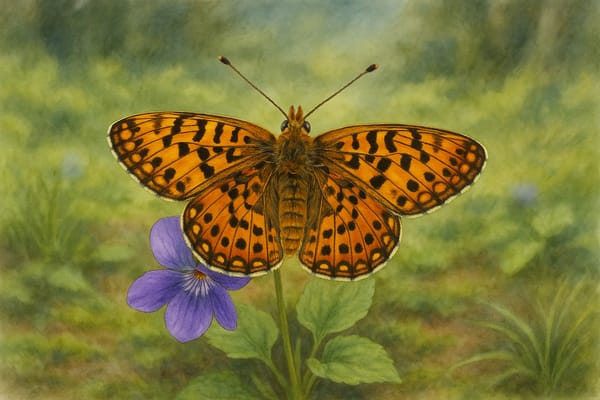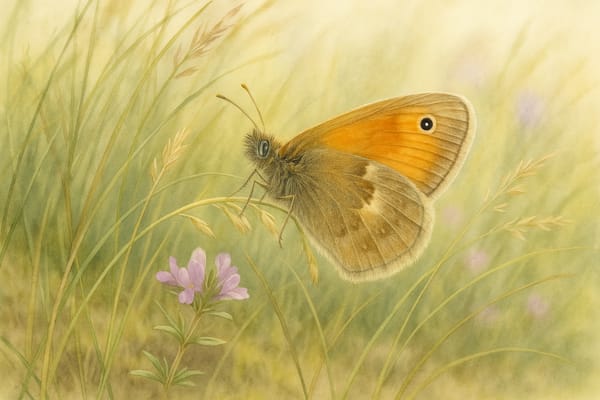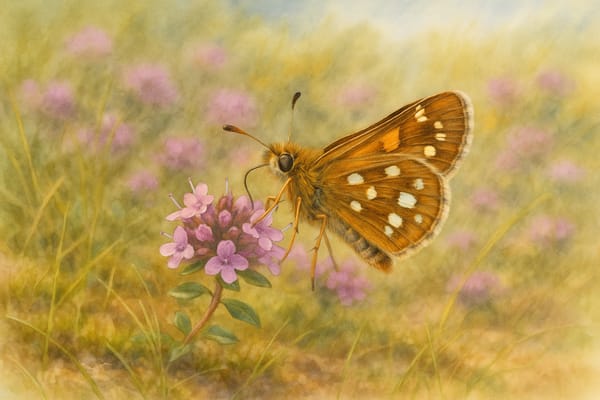In the warm hush of a summer afternoon, there’s a particular kind of magic that settles over a Cornish garden. It’s not just the salt-sweet air or the way the shadows soften among the hedgerows. It’s the flicker of life in motion — bees weaving from bloom to bloom, and butterflies lifting gently from one petal to the next. Their presence, delicate and purposeful, feels like both reward and reminder: this garden is alive.
To draw these pollinators in and welcome them as part of the fabric of the garden is to embrace a different kind of beauty. One that is not only visual, but essential. The hum of bees and the shimmer of butterfly wings mean that life is thriving. And in Cornwall, where native wildflowers tumble through hedgerows and coastlines pulse with wind-blown colour, there is no better palette to work with.
Flowers with Purpose: What to Plant
Certain flowers hold an almost magnetic pull for pollinators, especially when chosen with care and rooted in place. Some, like the bright blue cornflower or the cheerful orange faces of marigold, are generous with nectar and grow easily in Cornish soils. Others, such as borage — with its star-shaped blossoms and soft, cucumber-scented leaves — return year after year, seeding themselves like old friends who never truly leave.
Viper’s bugloss, with its bristling blue spires, is a marvel for bumblebees. You’ll often find them balanced upside-down within the flowers, legs powdered in pollen, wholly absorbed. Foxgloves, too, seem made for them. Tall and elegant, their tubular flowers hold deep reservoirs of nectar that only long-tongued bees can reach.
Some pollinators come not just for nectar but to raise their young. Bird’s-foot trefoil, low-growing and golden, feeds both butterflies and the caterpillars they once were. Wild herbs like lavender, particularly old varieties such as ‘Gros Bleu’, release a summer perfume that drifts across paths and patios, bringing bees in close, just where you want them.
There are also local stars. Cornish heath (Erica vagans), a true native, blooms late into summer and glows with pinks and purples along cliff paths and heathland. In the right spot — a well-drained, slightly acidic bed — it thrives at home in gardens too, buzzing with insects in the golden light of August.
Sedum offers a final act as autumn approaches. Its dusky heads open slowly and persist even as other flowers fade, becoming a landing pad for late hoverflies and bees, grateful for the last sweet drop before winter sets in.
Gardening for Life
To truly welcome pollinators, plant choice is only part of the picture. Consider the garden’s rhythm — not just its colours, but its continuity. Aim for flowers that appear from early spring right through to the cusp of winter. A patch of primrose or celandine can feed the first queen bumblebees emerging from hibernation in February. Later, red campion, knapweed, and devil’s-bit scabious carry the baton into autumn. And when the year wanes, ivy steps in with its creamy green blooms, among the last to offer sustenance.
It also helps to loosen your grip. Let your garden grow a little untamed at the edges. Leave clover, daisies, and self-heal in the lawn. Welcome so-called weeds that flower and feed. Mow less. Watch more.
And forget perfect order. Pollinators thrive in diversity — of shape, height, and structure. Combine ground-level blooms with vertical spikes like foxglove or echium, and let climbers like honeysuckle twist through fences. Each flower offers something slightly different: a shallow landing, a deep well of nectar, a scent trail carried on the breeze.
Avoid pesticides and synthetic fertilisers altogether. Even those marked as pollinator-safe can interfere with bees’ ability to forage, navigate, or reproduce. Instead, let nature govern balance. In a chemical-free garden, you’ll find more ladybirds, lacewings, and birds, all helping to keep pests in check.
Water is another kindness. A shallow dish filled with pebbles and rainwater is enough to refresh thirsty bees on warm days. Old wood, hollow stems, or a quiet corner of deadfall can offer shelter when blooms are scarce or weather turns harsh.
A Cornish Touch
There’s something deeply satisfying about choosing flowers that belong. Plants shaped by Cornwall’s winds, rain, and rugged coastline feel at home here. They have evolved alongside the pollinators that seek them.
You might sow a packet of Cornish wildflower seeds — a scattering of campion, poppies, corn marigolds, and knapweed — and let them naturalise in a patch of lawn. Or perhaps place a clump of lavender beside a favourite bench and sit quietly, letting the bees come to you.
Even the idea of “mullet gardening” — neat at the front, wild at the back — suits this place. It allows for a blend of structure and freedom, formality and instinct. In that balance, the garden begins to feel less like a performance and more like a conversation.
Living with the Winged Ones
To garden for butterflies and bees is to invite a little wildness, a little humility. It means giving up some control in favour of connection. But what you receive in return is extraordinary — a garden that moves and sings, one that breathes and feeds and sustains itself.
Over time, you begin to recognise the rhythm. The heavy drift of a bumblebee’s flight, the silent lift of a painted lady, the shy return of a peacock butterfly after rain. These aren’t ornaments. They are fellow travellers in the life of your garden. They remind us that gardening is never just about plants. It’s about relationships — between species, between seasons, and between ourselves and the land.
And here in Cornwall, where sea winds shape the hedgerows and wildflowers line the clifftops, there is no better place to begin.











